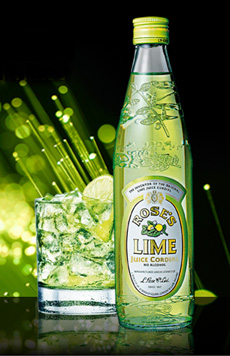TIP OF THE DAY: Make Your Own Lime Juice Cordial
|
Back in June we wrote about grenadine: How most commercial brands are made of high fructose corn syrup and artificial flavors and colors, and how you can make your own natural (and better tasting!) grenadine with pomegranate juice and sugar.
The same is true with lime juice cordial (also called lime cordial, and essentially lime syrup). Rose’s is the lime juice cordial most of us are familiar with. It’s lime juice concentrate and water, sweetened with high fructose corn syrup. The yellow-green color comes from Blue 1, an artificial food color. Sodium metabisulphite is added as preservative.* In the U.K., this type of concentrated fruit syrup is called squash or cordial, and is made from fruit juice, water and a sweetener. (The more sophisticated flavors contain herbal extracts, such elderflower and ginger.) For a soft drink, the cordial is mixed with club soda or water, in 1:5 proportion. Try it in ginger ale and cola, too. |
For a gourmet touch, make your own lime cordial. Photo courtesy Rose’s. |
|
|
The most popular use for the syrup in the U.S. is mixing with alcohol in a cocktail recipe. You can’t have a Gimlet or a Vodka Lime without lime juice cordial. *When Rose’s product was patented in 1867, sugar was used as a food preservative. Rose’s enabled fresh lime juice to be preserved without the addition of alcohol. Today, the brand is owned by the Dr Pepper Snapple Group. In the U.S., the sugar has long been replaced with HFCS. In the U.K. and Canada, sugar is still used: The regulators in those countries are not keen on HFCS. RECIPE FOR LIME JUICE CORDIAL This recipe makes about 3 cups. It has a shelf life of one to three months in the fridge. If you won’t use all of it, bottle it and give it to a cocktail- or soda-loving friend. Ingredients Preparation 1. Heat water to boil. WHEN NOT TO USE LIME JUICE CORDIAL Sometimes you want the flavor of lime juice cordial, sometimes you don’t. Because it’s easier and cheaper, some bars substitute lime juice cordial when fresh lime juice is called for—in a Cosmopolitan, Margarita or Mojito, for example. If you order a drink and anticipate a refreshing lilt of lime, you may be disappointed if the bar uses lime juice cordial. Ask if fresh-squeezed lime juice is used, and if not, request that yours be made with it. Every bar has fresh limes. The fresh juice makes a big difference.
|
||



